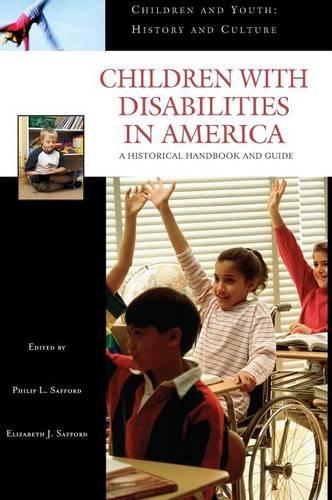
Children with Disabilities in America: A Historical Handbook and Guide
(Hardback)
Publishing Details
Children with Disabilities in America: A Historical Handbook and Guide
By (Author) Philip L. Safford
By (author) Elizabeth J. Safford
Bloomsbury Publishing PLC
Greenwood Press
30th December 2005
United States
Classifications
General
Non Fiction
Disability: social aspects
History of the Americas
362.70973
Physical Properties
Hardback
220
Width 178mm, Height 254mm
652g
Description
Images of disabled children are found throughout well-known works of literature, film, and even opera. Their characters range from sweet, to brave, to tragic. Disabled children are also a part of the reality of life either in personal ways or as poster girls and boys for drives and causes. Behind these images is a historical presence that has been created by the societies in which these children live and have lived. This work examines current knowledge about children's experience of physical, cognitive, and emotional/behavioral impairments from the Colonial period to the present, while revealing the social constructions of both disability and childhood throughout American history. Just as disability has been advanced as an essential consideration in other historical inquiries, such as that of gender, this is a work intended to demonstrate the critical role of disability with respect to the history of childhood.
Reviews
Disability in America, like race, is a social construct. Despite changes in laws and mores, children with disabilities grow up in a culture dominated by unexamined assumptions. The medical model of disability focuses on the disease and often ignores the context of the child's life. Many Americans were shocked by the demands for access and self-determination voiced by the disability rights movement that sprang up in the late 20th century. This book fills a void. Within it, readers will readily find stories of American childhood, education, special education, and the battle for inclusion. Few available works share the breadth of this title, other than academic dissertations and scholarly papers. The editors examine the images and realities for children with many different disabilities throughout American history. In the process they provide an excellent introduction for college readers and a solid reference source for further research. Highly recommended. All academic and public libraries; all levels. * Choice *
[A]n enlightening and sometimes disturbing collection of historical accounts by real people. It is well-indexed, footnoted and contains a bibliography of sources. This is an excellent resource for professionals who are working in the disability community. * Support for Families Newsletter *
Plenty of literary and social references speak of disabled children, but Children with Disabilities in America: A Historical Handbook and Guide takes a different tactic in considering the historical and social milieu of their issues. Chapters consider changing ideas and perceptions of disability, ability, behavior, and differences with articles surveying all types of disability, different movements in handling such children, and narratives on disability management. An excellent historical overview recommended for any college-level collection strong in health literature. * California Bookwatch *
[E]xamines current knowledge about the child's experience of physical, cognitive, and behavioral impairments from the Colonial period to the present. * PN *
Author Bio
PHILIP L. SAFFORD is Adjunct Professor, Department of Psychology, and Associate Director of Teacher Licensure, Case Western University. ELIZABETH J. SAFFORD is Reference Librarian, Nevins Library, Methuen, Mass.
